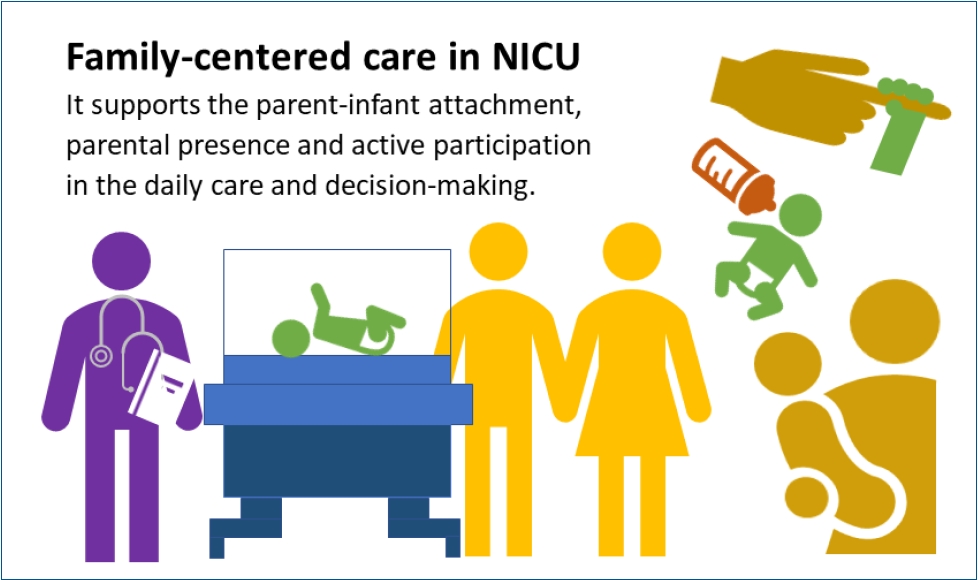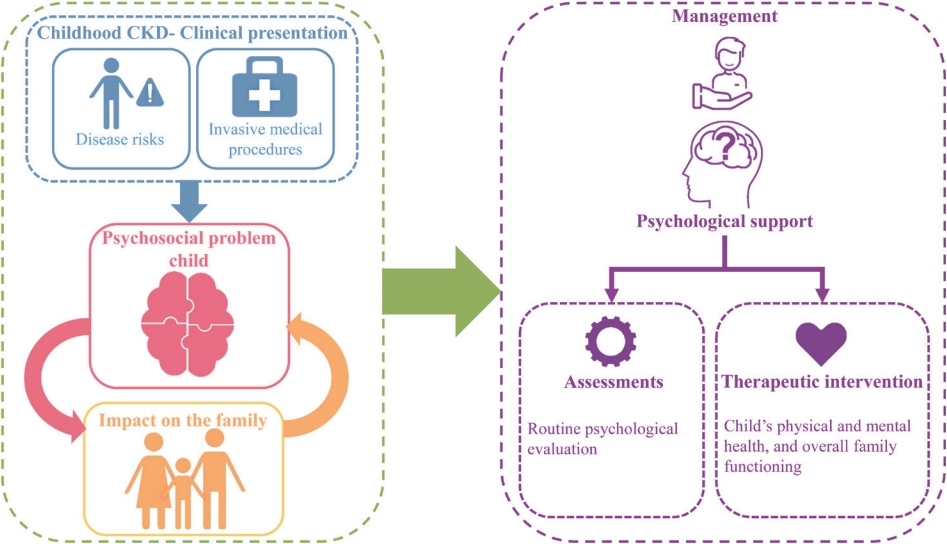Search
- Page Path
-
- HOME
- Search
- Review article
- Strategies to support language development in neonatal intensive care unit: a narrative review
- Ju Sun Heo, Ee-Kyung Kim
-
Despite neonatal intensive care advancements and quality improvements, preterm infants often experience delays in speech and language development during early childhood. The etiological pathway of language delays is multifactorial, including younger gestational age at birth, male sex, pregnancy complications including gestational diabetes mellitus and preeclampsia, organic pathology from neonatal morbidities, environmental factors of the neonatal intensive care unit (NICU) and... -
DOI: https://doi.org/10.3345/cep.2024.00087 [Accepted]
- Review Article
- Neonatology (Perinatology)
- Neonatal family-centered care: evidence and practice models
- Juyoung Lee
- Clin Exp Pediatr. 2024;67(4):171-177. Published online June 14, 2023
-

· Concrete evidence exists of early parent-infant attachment supported by family-centered care (FCC) in the neonatal intensive care unit.
· FCC involves the parents’ presence and participation in the infant’s care and decision-making.
· A private and comfortable space should be provided. A single-family room is ideal; however, a quiet space with a recliner can be a good alternative.
· Care culture changes and staff training are required.
- Neurobehavior
- Psychological aspects in children and parents of children with chronic kidney disease and their families
- Alemsungla Aier, Priya Pais, Vijaya Raman
- Clin Exp Pediatr. 2022;65(5):222-229. Published online November 10, 2021
-

· Childhood chronic kidney disease (CKD) is complex and requires lifetime medical treatment.
· Children with CKD are at risk for emotional, behavioral, social, and academic difficulties that significantly affect their quality of life.
· Caring for children with CKD is stressful for families.
· These unique challenges are crucial and can negatively impact treatment outcomes.
· Awareness of and addressing these evolving psychosocial issues can foster their developing needs.
- Original Article
- Effects of an intensive asthma education program on asthmatic children and their caregivers
- Kang Jin Seo, Gun Ha Kim, Byung Keun Yu, Yun Ku Yeo, Jong Hoon Kim, Eu Ddeum Shim, Mi Ri Yoon, Young Yoo, Ji Tae Choung
- Clin Exp Pediatr. 2008;51(2):188-203. Published online February 15, 2008
-
Purpose : Asthma is one of the most common chronic childhood disease. Education of asthmatic children and their families about asthma and its management may improve disease control, reduce symptoms, and improve school performance. The aim of the study was to evaluate the effects of an intensive asthma education program in asthmatic children and their families on outcome measure... -
- Review Article
- Concept of developmental disability and the role of a pediatrician
- Young Jong Woo
- Clin Exp Pediatr. 2006;49(10):1031-1036. Published online October 15, 2006
-
In this article, the following topics will be discussed: What is a developmental disability? What are the risk factors for developmental disability? What are the causes of delayed motor development? What are the early manifestations of developmental disability in young infants? What are the goals of early intervention and the forms or types of early intervention services? What are the... -
- Case Report
- Two Cases of Wolff-Parkinson-White Syndrome in a Family
- Chan Uhng Joo, So Hee Lim, Pyung Han Hwang
- Clin Exp Pediatr. 2002;45(9):1150-1154. Published online September 15, 2002
-
Wolff-Parkinson-White(WPW) syndrome is characterized by electrographic evidence of ventricular preexcitation, which predisposes to supraventicular arrhythmias. Familial occurrence of WPW syndrome is uncommon. We observed two affected siblings in a family. Five members of the family underwent 12-lead electrocardiography and echocardiography. Although known genetic abnormality of the 7q34-q36(PRKAG2) for the familial WPW syndrome was evaluated, the mutation was not detected in... -
- Original Article
- Molecular Cloning and Characterization of ETV1 : a New Member of the ETS Family Transcription Factor that is Implicated in Ewing's sarcoma
- In-sang Jeon, David N. Shapiro
- Clin Exp Pediatr. 1999;42(6):833-843. Published online June 15, 1999
-
Purpose : Ewing's sarcoma is characterized by accompanying specific chromosome translocations. In the present study, we report ETV1, the third member of the human ETS family that is implicated in Ewing's sarcoma by reciprocal translocation (7;22)(p22;q12). Methods : Primarily, cDNA library made from the Ewing's sarcoma cell line accompanying the t(7;22)(p22;q12) was screened using the 5' portion of EWS(including the... -
- The Significance of Family History, Immunoglobulin E, Total Eosinophils and Eosinophil Cationic Protein as a Predictor of Allergic Diseases
- Dong Su Park, Hyun Hee Kim, Joon Sung Lee
- Clin Exp Pediatr. 1998;41(9):1273-1282. Published online September 15, 1998
-
Purpose : Family history of allergy and cord blood immunoglobulin E concentration have been proven to be predictors of the development of allergic diseases in children. The purpose of this study is to evaluate whether maternal, cord and baby's blood total eosinophils or eosinophil cationic protein(ECP) in addition to the above two predictors could be a predictor of subsequent allergic... -
- Thin Glomerular Basement Membrane Disease Without Glomerular IgA Deposition in Children
- ll-Jou Sohn, Yong-Hun Park, Yong-Ho Ahn, Yong-Jin Kim, Woo-Young Chung
- Clin Exp Pediatr. 1997;40(7):974-980. Published online July 15, 1997
-
Purpose : Thin glomerular basement membrane (TGBM) disease is now recognized as one of leading causes of isolated microscopic hematuria, regarded as a benign condition and characterized by the presence of familial benign hematuria. But there are few studies of TGBM in Korea. The purpose of this study was to evaluate the clinical and pathological findings in TGBM according to... -
- A Study on the Relationship between Juvenile Delinquency and Family Environment
- Duk Jin Yun, Jung Kyoo Park, Jong Bok Chung, Jung Mo Nam, Jong Yun Park
- Clin Exp Pediatr. 1993;36(2):195-207. Published online February 15, 1993
-
This study was conducted to find out an appropriate means for preventing the juvenile delinquecy(JD), which is supposed to be greatly realted to family environment. The data were collected through a questionnaire survey with a means of writing by themself, to 257 middle and high school students and 309 juvenile delinquetns who were in confinement. The question-naire was consisted of 27... -
- One Case of Recovery Phase of Aplastic Crisis in Hereditary Spherocytosis with Family History.
- Eun Kyung Won, Dong Hyeon Kim, Ho Seung, Chang Hee Choi
- Clin Exp Pediatr. 1990;33(10):1434-1440. Published online October 31, 1990
-
We experienced a case of hereditary spherocytosis patient who was in a recovery phase of aplastic crisis at the time of presentation. This was a 7 years old boy with complaints of pallor and intermit- tent abdominal pain. Asymptomatic jaundice was also found in the patient's grandfather and two maternal uncles. Patient’s mother had splenectomy due to hereditary spherocytosis. Diagnosis was made by morphology,... -
- A Study on the Growth Pattern, History of Respiratory Illness and Family History in Acute Bronchiolitis.
- Dong Won Choi, Byung Ju Jung, Kyu Earn Kim, Ki Young Lee
- Clin Exp Pediatr. 1990;33(5):623-631. Published online May 31, 1990
-
The authors evaluated the growth pattern, history of frequent respiratory illness and family history in 111 infants who were admitted to the Department of Pediatrics, Yonsei University Hospital with the diagnosis of acute bronchiolitis from Sept. 1986 to Jun. 1988. The results of the study were as follows: 1) The sex incidence of bronchiolitis was higher in males compared with the sex incidence of the total... -
- Hepatitis with Positive HBsAg in 3 Generations in 3 Families.
- Dong Hak Shin
- Clin Exp Pediatr. 1987;30(11):1265-1273. Published online November 30, 1987
-
Since Jolly reported multiple occurences of cryptogenic cirrhosis in children in a family members in 1892, there had been sporadic cases reported and this familial liver cirrhosis was called as familial juvenile cirrhosis by Gunn. In 1960, numer of family pedigree of chronic liver diseases (such as chronic hepatitis, liver cirrhosis and liver cell carcinoma) in adult was more numerous than that of in... -
- Case Report
- Pseudohypoparathyroidism and Peudopseudohypoparathyroidism in a Family.
- Young Cherl Lee, Duk Hee Kim, Chang Jun Coe
- Clin Exp Pediatr. 1984;27(11):1128-1134. Published online November 30, 1984
-
We are reporting the cases of 2 patients in a family, younger sister and elder brother, who exhibit skeletal and physiognomonic characteristic pictures of PHP and PPHP. In this report, we illustriated pertinent clinical and pathologic features of this diseases in children and revi- ewed the literature concerning this diseases. -
- Original Article
- A Clinical Study of Tic Disorder in Korea.
- Kang E Hong
- Clin Exp Pediatr. 1981;24(3):198-208. Published online March 15, 1981
-
30 patients diagnosed as having tic disorder at the Child Psychiatry clinic of Seoul National University Hospital were studied in terms of sex, age, onset, precipitating factors,characteristics of the patients and family dynamics. A short term follow up study wascarried out regarding the outcomes of the symptom and the changes in attitudes and beha-viors of patients and parents. The results... -
-

-
-
Impact Factor3.2
-
8.02023CiteScore94th percentilePowered by
-









